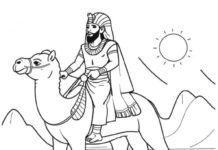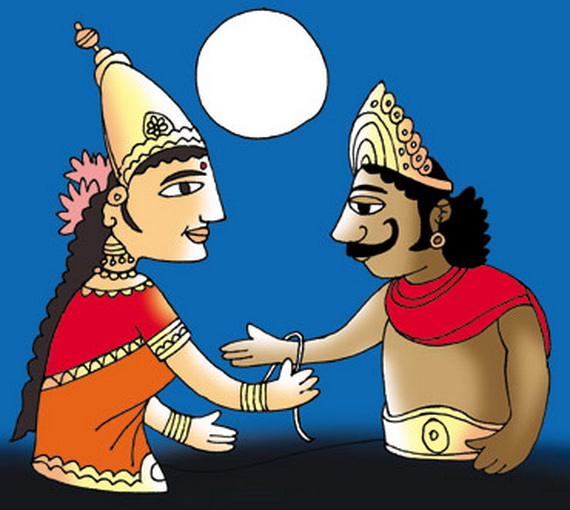Raksha Bandhan (the bond of protection) or Rakhi is a Hindu festival and also Sikh festival falls in the holy month of Shravan, which celebrates the relationship between brothers and sisters celebrating the bond of love among them.
It is celebrated on the full moon of the month of Shraavana the Hindu lunisolar calendar.
Like all other Indian festivals, Raksha Bandhan is a popular practice which has a long historical background and numerous legends associated with its origin.
It is really difficult to trace the origin of rakhi as there are various stories and incidents associated with its history. According to Hindu mythology, most of the roots of Hindu festival can be dated back to the mythological Pouranik times.
The festival nurtures a varied and rich heritage of legendry epics.
It is this bond of togetherness that binds us. So There are many interesting legends associated with the Rakhi history, these are the few legends associated with the festival of Rakhi, which signifies the importance of Raksha Bandhan celebration in India.
Mythical and Historical Occurrences and Mentions:
1- Legend of Indra and Indrani:
According to Bhavishya Purana there was a war between gods and demons, and Indra (the king of the gods) was defeated by the demons and, the Gods were on the verge of defeat.
At that time Indra consulted his Guru Brahaspati for an advice; Indra’s wife Sachi took a holy silken thread, popularly known as ‘Raksha’ and charged it with sacred verses for protection and tied it on Indra’s the right wrist.
As a result of the power of the sacred thread it enhanced Indra with the power of mind, decision–making, Bhava and merits. Raksha helped in protecting the Gods from the clutches of the evils. Indra conquered his enemies and successfully defeated the demons and bought victory for the Gods.
Since then till today this festival is celebrated and the tradition of tying a thread is going on as a gesture of concern. It is considered as gesture of goodwill and protection.
This is how the custom of Raksha Bandhan seems to have originated.
This was done to invoke blessings of the God. Before the men departed for the battlefield, their womenfolk tied sacred threads or amulets to protect them and also to remind them of their duties to uphold the honor of their tribe.
2 -Legend of Santoshi Maa:
Now even though this tale has no basis in the Hindu scriptures, the take of the birth of Santoshi Maa has been linked to the festival of Raksha Bandhan.
The tale of the deity Santoshi Mata, and the narrative of her creation on Raksha Bandhan day, was popularized in the 1975 Bollywood blockbuster Jai Santoshi Maa. the tale goes somewhat like this:
Lord Ganesha’s had two sons, Shubh and Labh. On Raksha Bandhan, Ganesh’s sister Manasa visited him and tied a rakhi on Ganesh’s wrist. On seeing this, Ganesha’s sons — Shubha and Labha –Feeling deprived, the sons immediately and his two wives, Riddhi and Siddhi began pressingand insisting Ganesh for a sister.
Finally, giving in to their demands, Santoshi Ma (literally the Mother Goddess of Satisfaction) was created by divine flames that emerged from Riddhi and Siddhi.
3- Legend of Lord Krishna and Draupadi:
Another incident from the epic Mahabharat concerns Krishna and Draupadi, the wife of the Pandavas. Legend goes that during the war that Krishna fought and won against the evil King sari wherein he killed sari, Krishna was hurt and his hand was bleeding.
Seeing this, Draupadi tore a strip of silk from her sari and tied it around his wrist to stanch the bleeding from a battlefield wound. Draupadi, was married to five great warriors Pandavas and a daughter of a powerful monarch.
Lord Krishna was touched, seeing her affections and realizing her concerns about him, declared himself bounded by her sisterly love even though they were unrelated.
He also promised to protect her in time of distress whenever she needed a brother and to repay the debt and then spent the next 25 years doing just that. Legends show that Draupadi depended wholly on Krishna.
Many years later, when Pandavas lost Draupadi in a game of dice which occurred in the assembly of King Dhritarashtra, Kauravas were removing her sari, Krishna helped her saving her honor and repaid the debt of love. He did so by continuously adding to the length of her sari and thereby saved her from a public disgrace.
4-Legend of King Bali and Goddess Laxmi
According to the mythological tale, it is linked with Goddess Laxmi’s, Rakhi tying to Bali. The Demon King Bali was a great worshipper of Lord Vishnu.
Lord Vishnu seeing the devotion of King Bali, he had taken up the task to guard his kingdom leaving his own abode Vaikuntham, his dwelling to protect Bali’s kingdom. Goddess Lakshmi (Lord Vishnu’s wife) became sad and wished to be with her lord back in her abode instead of being left alone.
She went to Bali disguised as a Brahmin woman to seek refuge in the King’s palace till her husband came back.
During the Shravan Purnima celebrations, Lakshmi tied the sacred thread a yellow Rakhi to the King Bali’s wrist then revealed her true identity and told the King why she was there and her real reason for coming. The king was touched by her goodwill and affection for him and his family and requested the Lord to accompany her to Vaikuntham. He sacrificed all he had for the Lord and his devoted wife.
It is due to the extreme devotion to the Lord the festival of Rakhi also came to be known as Baleva (as a reference to Bali’s devotion to Lord Vishnu) and since then it has been a tradition to invite sisters in Shravan Purnima for the thread tying ceremony or the Raksha Bandhan.
5- Legend of Yama and the Yamuna:
Yama and Yamuna add to the significance of Raksha Bandhan immensely.
According to this legend, Raksha Bandhan was a ritual followed by Lord Yama (the Lord of Death) and his sister Yamuna, (the river in northern India).
Yamuna tied rakhi to Yama and by this Yama gained immortality.
Yama was so moved and was completely taken in by the import of the gesture and by the serenity of the occasion that he declared that whoever gets a rakhi tied from his sister and stood by their promise to protect their sister would be blessed and become immortal.
6 -Legend of Alexander the Great and King Puru:
According to one legendary narrative it was that when Alexander the Great invaded India in 326 BC on his mission to conquer the world, his wife, Roxana approached King Puru as a sister. She sent Porus, a sacred thread and asked him not to harm her husband on the battlefield.
Honoring the request and in accordance with tradition, when Porus, a Katoch king confronts Alexander he gave full respect to the rakhi refusing s to kill him. On the battlefield, when Porus was about to deliver a final blow to Alexander, he saw the rakhi on his own wrist, as a tribute to this sacred bond of Rakhi he restrained himself from attacking Alexander personally and let him have his way. Eventually, Porus would lose the battle of the Hydaspes River but would gain Alexander’s respect and honor.
Eventually, after his death, Porus would become a very loyal Macedonian satrap.
7 -Legend of Rabindranath Tagore & Rakhi:
A Famous Bengali Poet Rabindranath Tagore (1861-1941) had a vision of celebrating Raksha Bandhan which was totally different.
According to him Rakhi is not only a festival of the siblings brothers and sisters but it’s a celebration of mankind for kindness and of humanity among all members of the society. Its concept teaches us to think and care for others.
During the partition of Bengal by the British empire in 1905 to a state of British India on the basis of caste and religion, Rabindranath Tagore, the Nobel laureate poet used the occasion of the Raksha Bandhan as a community festival and gave a call to tie a rakhi amongst all Hindus and Muslims to strengthen the bond of love and togetherness as to maintain peace and harmony between them and spread the nationalist spirit among people from different ethnic backgrounds and finally to fight together against the British empire.
Tagore used a white thread for Raksha Bandhan thus made white Raksha Bandhan popular among Friends.
People now a day tie Rakhi to their neighbors and close friends signifying a peaceful co-existence of every individual as a symbol of universal brotherhood and goodwill.
8- Legend of Rani Karnavati and Emperor Humayun:
History evidences show that during Mughal period the custom of tying rakhis helped bind the Hindu Rajputs and Mughal rulers together.
One of the most popular tales centered on Rakhi is that of Rani Karnawati of Chittor and Mughal Emperor Humayun which dates to the medieval era 1535 CE when Rajputs were fighting Muslim invasions.
According to legend, when Bahadur Shah of Gujarat attacked Rani Karnavati the widowed queen of the king of of Chittor, she sent a rakhi to the Mughal emperor Humayun as bond of love when she realised that she could not defend the invasion and requested him to save her kingdom from the invasion of Bahadur Shah of Gujarat. The Emperor, touched by this gesture of sisterly love immediately set off with his troops to defend Chittor’s honour.
So all of these legends associated with the festival teaches us one thing that there is nothing above true love and affection.
Such happenings over the centuries have strengthened the bonds of affection between brother and sister which in fact are reaffirmed every year on the day of Raksha Bandhan.










































